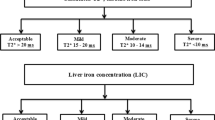Abstract
Iron overload is one of the major prognostic factor in thallassemia patients. We aimed to evaluate iron accumulation in the heart and liver by MRI in thalassemia major, thalassemia intermedia, and S-ß thalassemia patients and to examine its association with ferritin and hepcidin levels. Serum ferritin and hepcidin levels were recorded. Iron overload (IOL) in the heart and liver parenchyma was determined based on the standardized T2* and R2 values measured by MRI. The results were evaluated considering the tissue iron overload, serum ferritin and hepcidin levels. Comparing the 109 patients with the 30 healthy controls revealed the mean age: 24.4 ± 11 versus 31.2 ± 5 years, median levels of serum ferritin: 1693 versus 40 ng/mL, and hepcidin: 1.94 versus 0.355 ng/mL; p < 0.001, respectively. Comparison of age, serum ferritin and hepcidin levels and MRI findings of the patients with or without IOL revealed that, ferritin and T2* were significantly different in the patients with IOL in cardiac tissue (p = 0.004 and p < 0.001), and, age, ferritin and R2 were significantly different in the patients with IOL in liver tissue (p = 0.036, p < 0.001 and p < 0.001). The MRI-based T2* and R2 values were moderately and inversely correlated with serum ferritin (r = −0.37; p < 0.001 and r = −0.46; p < 0.001). No correlations were found between the MRI-based T2*, R2 values and serum hepcidin. A moderate and positive correlation existed between serum ferritin and hepcidin (r = 0.45; p < 0.001). We considered that, enhanced intestinal iron absorption characterized by decreased serum hepcidin levels in the intervals between successive transfusions were resulted in iron accumulation in our patients.
Similar content being viewed by others
References
Weatherall DJ, Cleeg JB (1980) The clinical and molecular heterogeneity of the thalassemia syndromes. Ann N Y Acad Sci 344:83–100
Taher AT, Viprakasit V, Musallam KM, Cappellini MD (2013) Treating iron overload in patients with non-transfusion-dependent thalassemia. Am J Hematol 88:409–415
Hamed AA, Elguindy W, Elhenawy YI, Ibrahim RH (2016) Early cardiac involvement and risk factors for the development of arrhythmia in patients with β-thalassemia major. J Pediatr Hematol Oncol 38(1):5–11
Kolnagou A, Yazman D, Economides C, Eracleous E, Kontoghiorghes GJ (2009) Uses and limitations of serum ferritin, magnetic resonance imaging T2 and T2* in the diagnosis of iron overload and in the ferrikinetics of normalization of the iron stores in thalassemia using the international committee on chelation deferiprone/deferoxamine combination protocol. Hemoglobin 33(5):312–322
Olynk JK, O’neil R, Britton RS, Bacon BR (1994) Determination of hepatic iron in fresh and paraffin embedded tissue: diagnostic Implications. Gastroenterology 106:674–677
Fisher R, Harmatz PR (2009) Non-invasive assessment of tissue iron overload. In: Gewirtz AM, Keating A, Thompson AA et al (eds) Hematology 2009, vol 1. American Society of Hematology Education Program Book, New Orleans, pp 215–221
St. Pierre TG, Clark PR, Chua-Anusom W (2005) Measurement and mapping of liver iron concentration using magnetic resonance imaging. Ann N Y Acad Sci 1054:379–385
Anderson LJ, Holden S, Davis B et al (2001) Cardiovascular T2-star (T2*) magnetic resonance for early diagnosis of myocardial iron overload. Eur Heart J 22:2171–2179
Mazza P, Giua R, De Marco S, Bonetti MG, Amurri B, Masi C et al (1995) Haematologica 80:398–404
Gardenghi S, Grady RW, Rivella S (2010) Anemia, ineffective erythropoiesis and hepcidin: interacting factors in abnormal iron metabolism leading to iron overload in β-Thalassemia. Hematol Oncol Clin North Am 24(6):1089–1107
Borgna-Pignatti C, Galanello R (2009) Thalassemias and Related Disorders: Quantitative disorders of hemoglobin synthesis. In: Greer JP, Foester J, Rodgers GM et al (eds) Wintrobe’s clinical hematology, 12th edn. Lippincott Williams & Wilkins, Philadelphia, pp 1083–1131
Yılmaz B, Balım Z, Ozkınay Gunduz C, Altıntas N, Aydınok Y et al (2000) Molecular genetic analyses of Beta-Thalassemia patients. Ege Tıp Dergisi 39(3):153–157
Ghazi O, Tadmouri A, Başak N (2001) β-thalassemia in Turkey: a Review of the clinical epidemiological molecular and evolutionary aspects. Hemoglobin 25(2):227–239
Gümrük F (2012) Hemoglobin ve Hemoglobinopatiler. In: İliçin G, Biberoğlu K, Süleymanlar G, Ünal S (eds) Hastalıkları. 3. Baskı. Güneş Kitabevi, Ankara, pp 1634–1644
Karakas Z (2010) Principles of transfusion in Thalassemia. Turkiye Klinikleri J Hem Onc Special Topics 3(1):50–57
Cunningham MJ, Sankaran VG, Nathan DG, Okrin SH (2009) The Thalassemias. In: Orkin SH, Nathan DG, Ginsburg D, Look AT, Fisher DE, Lux SE et al (eds) Nathan and Oski’s hematology of ınfancy and childhood, 7th edn. Saunders Elsevier, Philadelphia, pp 1015–1107
Peters TJ, Raja KB, Simpson RJ, Snape S (1988) Mechanisms and regulation of intestinal iron absorption. Ann N Y Acad Sci 48:541–547
Nemeth E (2010) Hepcidin in β-Thalassemia. Ann N Y Acad Sci 1202:31–35
Wood JC, Origa R, Agus A, Matta G, Coates TD, Galanello R (2008) Onset of cardiac iron loading in pediatric patients with thalassemia major. Hematologica 93(6):917–920
Tokgöz H, Çalışkan Ü (2010) Iron regulation, metabolism and measurement of overload in thalassemia. Turkiye Klinikleri J Hem Onc Special Topics 3(1):70–75
Ganz T, Olbina G, Girelli D, Nemeth E, Westerman M (2008) Immunoassay for human serum hepcidin. Blood 112:4292–4297
Author information
Authors and Affiliations
Corresponding author
Ethics declarations
Conflicts of interest
All authors declare no conflicts of interest.
Informed Consent
Informed consent was obtained from all the individual participitants included in this study.
Ethical Approval
All procedures performed in studies involving human participants were inaccordance with the ethical standards of the institutional and/or national research committee and with the 1964 Helsinki declaration and its later amendments or comparable ethical standards.
Rights and permissions
About this article
Cite this article
Karakus, V., Kurtoğlu, A., Soysal, D.E. et al. Evaluation of Iron Overload in the Heart and Liver Tissue by Magnetic Resonance Imaging and its Relation to Serum Ferritin and Hepcidin Concentrations in Patients with Thalassemia Syndromes. Indian J Hematol Blood Transfus 33, 389–395 (2017). https://doi.org/10.1007/s12288-016-0735-2
Received:
Accepted:
Published:
Issue Date:
DOI: https://doi.org/10.1007/s12288-016-0735-2




